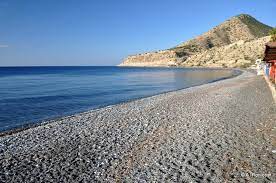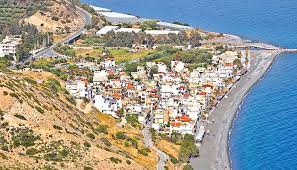Myrtos is a seaside village west of Ierapetra city, in Lassithi region 15 km far. It is located 50 km far from Agios Nikolaos. West of the village is the Kolektos mountain. Myrtos is SOUTH in Libyan sea. Myrtos Ierapetra located east of Crete in a very warm place all year hosting many Europeans. GPS Coordinates for Myrtos are 35.0036111° N and 25.5844444° E.




You can drive to Myrtos Ierapetra by car, the safest and easiest way to visit the place.
On September 15, 1944, during the II WW, the inhabitants of Myrtos Ierapetra were ordered by the Nazi-German occupiers to leave the village. Many refused to do so, resulting in the massacre of eighteen inhabitants as a reprisal and the almost complete destruction of the village by fire.
Tourism started at the beginning of the ’70s. Initially, Mirtos was especially popular amongst 1970’s hippies but later also ‘regular’ tourists started to visit the village. Since the 1980s, apartment complexes have been built in Myrtos, but tourism in Myrtos is still relatively small-scale and nowhere near as developed as the tourist centers which are found on the North coast of Crete.
Myrtos Ierapetra has a warm “sub tropical” climate. The temperature in the south of Crete is a couple of degrees higher than in the north, because the colder winds from the north are blocked by mountain Dikti (whose highest point is 2,150 metres or 7,050 feet).
The average temperature in the warmest months of the year (July and August) is around 28° Celsius (82 °F), though sometimes it can exceed 40° Celsius (105 °F). The temperature during the coldest months of the year (January and February) averages about 13-14° Celsius (55 °F) but on rare occasions it can also snow in Myrtos.
Myrtos Ierapetra has a long beach consisting not just of sand, but also of fine-grained pebbles. The beach has received the “blue beach flag”, which means the beach is clean and safe. The nearby village of Tertsa also has a very long beach. On the two outlying beaches of Tertsa, nudism is allowed by the Greek authorities. If you are starting from Agios Nikolaos, Sitia or Ierapetra, take the tarmac district road west. In about 16 km you will find yourself in Mirtos, at the mouth of the River Kryos.
Myrtos is also the location for two archaeological sites of Minoans, Pyrgos area and Fournou Korifi.
In Myrtos there is a small museum, dedicated to the local history, which features a scale model of Fournou Korifi created by John Atkinson, a British potter resident in the village who is the current museum curator. Near the small village Mythoi, about 5 km from Myrtos. Kritsa village is also a close place to visit.
The areas surrounding Myrtos are still dominated by greenhouses often composed only of wooden frames covered with plastic sheeting. This is a video shot from Mr Somarakis, showing the place of Mirtos.
